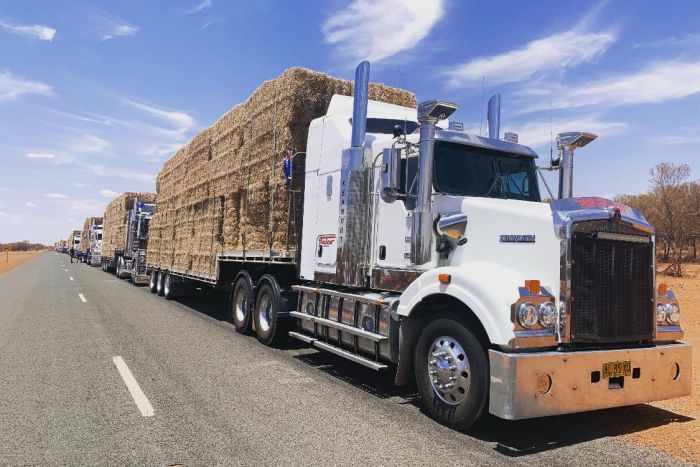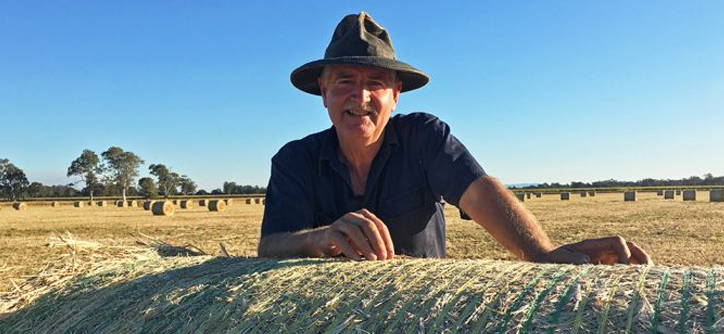We have seen considerable press about stock feed moving around the country to support drought-stricken primary producers. Trucks loaded with hay have been regular and emotive vision on our televisions and in our press.
Hay contractor kelvin Hamilton says that the demand for hay this year has been the greatest he’s seen in almost 30 years in the business. (Picture above) (ABC: Kim Honan).
Elsewhere there has been discussion about the distortion to the fodder market that charitable acquisition of stock feed may cause, see ABC report on hay ‘gazumping’. If you want to read more about that.
In this article, we will think about the ‘aftereffects’ of bringing in hay and other feeds often from unknown sources.
 The Burrumbuttock Hay Runners convoy hits the road. (Supplied: Brendan Farrell) ABC.net.au
The Burrumbuttock Hay Runners convoy hits the road. (Supplied: Brendan Farrell) ABC.net.au
Meat & Livestock Australia (MLA) recommends ( Commodity Vendor Declarations (CVD) for Stock Feeds ) that all stock feeds brought on the farm be accompanied by a CVD. Specifically, the CVD will identify the origin and certify the chemical application history for the feed. The MLA Livestock Production Assurance Program (LPA) requires that compliant producers maintain records of all introduced stock feeds, the above link for CVD has useful tools and resources to assist stock feed suppliers and recipients, including record templates and declarations.
It has long been recognised that introducing feed from external sources brings the risk of the introduction of weed seeds. The drought conditions across much of Eastern Australia has resulted in massive movements of hay, and feed grains, magnifying the risk of weed spread. In July 2018 Toni Somes, reporting for the GRDC:
Grains Research and Development Corporation (GRDC) Crop Protection Officer North Vicki Green said the movement of hay between regions and states had the potential to spread problem weeds.
“Like grain, hay can contain many weed seeds, and in the current drought conditions stockfeed is being transported vast distances as producers source whatever they can, from wherever they can,” she said.
“During dry times, I have heard anecdotal reports of hay contaminated with weed seeds affecting different properties more than 500km apart, resulting in significant infestations of new weeds.
“There is also the chance that these weed seeds will be herbicide-resistant.
“This is a potentially serious problem for agricultural production in general, with negative impacts for both cropping and pasture.”
Australian States all have quarantine regulators for the interstate movement of plant material, visit this list of regulators to see contact details for your state.
For example: In NSW the DPI has restrictions on certain lupin materials from SA & WA:
 For more examples of NSW fodder requirements purchased from Interstate visit DPI Feed & Fodder entry requirements.
For more examples of NSW fodder requirements purchased from Interstate visit DPI Feed & Fodder entry requirements.
So; you’ve sourced for feed for your stock, difficult to find & expensive to bring in, and now you are starting to feed out, what are the risks and how do you best manage those risks?
A common thread in most published advice is to restrict the feeding out of introduced feed to ‘quarantine’ areas; designate small paddocks where hay is fed out & trail out grains in restricted areas.
In Queensland the Dept Science, Information Tech and Innovation have this to say:
Feeding out fodder
Weed seed can be spread by livestock both directly, when seeds become attached to their hooves and body, and indirectly via livestock manure. Restricting the dispersal of weed seed via livestock can limit the scale of new weed incursions.
• Choose flat, arable areas with easy access for feeding out fodder as this encourages weed germination in situ. It also increases options for control should weeds germinate to include mechanical, chemical, biological control and/or management by grazing Department of Science, Information Technology and Innovation 10
• Feed out fodder in restricted areas or paddocks quarantined from the rest of your property which can be regularly monitored for weed germination
• By restricting livestock movements to accessible paddocks after feeding out, all weed seed that passes through their digestive system can be controlled if germination occurs. This prevents seeds from being transported away from the quarantined area and spread across your property.
More can be found at the full article from Qld Gov publications.
Restricting feeding to designated areas, smaller paddocks, has several benefits:
- Less paddock degradation
- Confines potential weed infestation to known & manageable areas
- Stock save energy by having to walk less
- At the break of the season other areas are allowed to grow fodder before grazing pressure.
Once the season breaks BE PREPARED, expect a weed breakout in the ‘feed-out’ areas. Carry a sprayer appropriate to the stage of weed development and size of the risk area. Use an appropriate weedicide, refer to label for application rate.
Article courtesy of Hugh Bygott.




